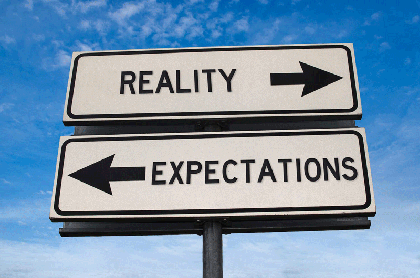Face reality and Let Go of Hope for change in your partner
Remaining hopeful that your partner will change in an unhealthy relationship can be a binding trap. Clinging to the belief that your partner will transform during fleeting moments of harmony and bliss often keeps you ensnared in a harmful cycle without any meaningful change over the years.
In healthy relationships, natural ebbs and flows of harmony, disruption, and resolution are common. Continuous harmony is a rarity, even in strong relationships, occurring only about 30% of the time. The remaining 70% is characterized by moments of conflict followed by constructive ways to address and resolve issues, ultimately strengthening trust in the relationship.
Unhealthy Relationship Patterns
At the beginning of most relationships, both partners typically present their most agreeable sides during the mutual discovery phase, fostering positive feelings and deepening love that leads to commitment. However, as couples progress into the committed phase, they often encounter unexpected issues due to a lack of conflict resolution tools. Some common problematic behaviors in unhealthy relationships include:
1. Refusal to take responsibility, instead blaming their partner and turning issues into character flaws or deficiencies.
2. Emotional withdrawal, using silence as a means to punish the partner for perceived hurts.
3. Taking initial ownership of the problem but later holding the other responsible for the issues.
4. Claiming superiority and expecting the final say, demanding agreement or silence from the other.
The hopeful partner, despite their reservations, often welcomes a return to a familiar, positive connection and gives in to the destructive approach, leading to temporary relief before the cycle repeats.
The Illusion of Harmony
In this relationship cycle, moments of "harmony" following disruptions can create a deceptive sense of "repair," fostering false hope that change is possible. These sporadic positive experiences can lead to denial of the underlying problems.
Embracing Conflict
To avoid these issues when seeking a partner, it's crucial to be authentic, express your desires and expectations, and engage in healthy disagreements during the dating phase. Conflict, when handled well, can reveal a potential partner's ability to resolve problems. Thriving relationships experience disruptions and conflicts but maintain open communication and a safe environment for addressing needs.
Letting Go of Hope for Change
If you're stuck in a relationship where problems are not being resolved in a balanced manner, it's essential to consider strategies to regain control over your life. Here are practical steps to help disentangle yourself from a relationship that no longer serves your well-being:
1. Self-Reflection
Reflect on your happiness and assess your needs and boundaries.
2. Seek Support
Reach out to trusted individuals for emotional support and guidance.
3. Set Boundaries
Communicate your needs and establish clear boundaries in the relationship.
4. Counselling or Therapy
Consider professional help to address relationship issues.
5. Weigh the Pros and Cons
Objectively evaluate the relationship to determine if it's worth salvaging.
6. Legal Matters
Consult with a lawyer for guidance on legal and financial aspects.
7. Plan for Independence
Make plans for your independence, including securing a support network.
8. Be Prepared for Change
Recognize the emotional challenges and seek professional help as needed.
9. Prioritize Self-Care
Focus on your well-being during the transition.
10. Follow Through
Be resolute in your actions and seek guidance from professionals or support groups.
Leaving a stagnant or abusive relationship can be a challenging process, but it's often necessary for personal growth and well-being.
Remember that you deserve a healthy, fulfilling, and mutually respectful relationship. By taking these steps and seeking the right support, you can regain control over your life and move toward a brighter future.



















